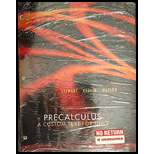
(a)
Whether: subtraction is commutative.
(a)
Answer to Problem 85E
Subtraction is not commutative.
Explanation of Solution
Calculation:
Try to find a counterexample to the statement “Subtraction is commutative.” If we can find even example in which subtraction is not commutative, we can say that the statement is false. Let’s assume that subtraction is commutative. This means that for any numbers
Let’s take two numbers. Let
Let’s perform the subtractions.
Now, reverse the numbers,
Since 1 and -1 are not equal, the subtraction order cannot be switched to produce the same results. This provides a counterexample for our argument. Therefore, subtraction is not commutative.
(b)
Whether the division of nonzero real numbers commutative.
(b)
Answer to Problem 85E
For nonzero real numbers division is not commutative.
Explanation of Solution
Calculation:
Try to find a counterexample to the statement “divison is commutative.” If we can find even example in which subtraction is not commutative, we can say that the statement is false.
Let’s assume that division is commutative. This means that for any nonzero numbers
Let’s take two nonzero real numbers. Let
Let’s perform the divisions.
Now, reverse the numbers,
Since 2 and
Chapter 1 Solutions
Precalculus - A Custom Text for UNLV
- Thank you for your help!arrow_forwardi Compute the given determinant by cofactor expansions. At each step, choose a row or columnthat involves the least amount of computation.7 6 8 40 0 0 68 7 9 30 4 0 5arrow_forwardi Compute the inverse of the matrix below using row operations. Please show your work.1 0 −2−3 1 42 −3 4 This is a 3*3 matrix. First row is 1 0 -2.arrow_forward
- Solve the system of equations below by applying row operations on the corresponding aug-mented matrix to convert it to the reduced row-echelon form. Write the solutions using freevariables as parameters.x1 + 3x2 + x3 = 1−4x1 − 9x2 + 2x3 = −1−3x2 − 6x3 = −3arrow_forwardFind L{f(t)} f(t) = tsin(t)arrow_forwardwhat is the horizonal asymptote of question d?arrow_forward
- 2 3 Polar axis The graph of the polar function r = = f(0) is given in the polar coordinate system. Which of the following defines f(0) for 0 ≤ 0 ≤ 2πT? A 3+ cos(30) B 3 cos(30) C 3+ sin(30) D 3 sin (30)arrow_forwardSolve by superposition method the following DE: y^(4) - y = xe^(x) sen(2x), conditions: y(0) = y'(0) = y''(0) = y'''(0) =0arrow_forwardUse the annulus method to find the solution of the DE: y''' + 8y = e^(3x) sen(3x) cos(3x)arrow_forward
- 3:59 m s ☑ D'Aniello Boutique | Fashion VOLTE danielloboutique.it/asia SUBSCRIBE NOW: 10% OFF TO USE ANYTIME YOU WANT d'aniello NEW IN WOMEN NEW IN MEN WINTER SALE: 50% OFF on FW24 SHOP WOMEN SHOP MENarrow_forwardJOB UPDATE EMERSON GRAD ENGINEER (FRESHERS) SOFTWARE ENGG NEW RELIC BROWSERSTACK (FRESHERS) SOFTWARE ENGG FULL STACK DATA ENGINEER GENPACT + PYTHON CARS24 WORK FROM HOME #vinkjobs TELE PERFORMANCE Vinkjobs.com CUSTOMER SUPPORT Search "Vinkjobs.com" on Googlearrow_forwarddo question 2 pleasearrow_forward
 Calculus: Early TranscendentalsCalculusISBN:9781285741550Author:James StewartPublisher:Cengage Learning
Calculus: Early TranscendentalsCalculusISBN:9781285741550Author:James StewartPublisher:Cengage Learning Thomas' Calculus (14th Edition)CalculusISBN:9780134438986Author:Joel R. Hass, Christopher E. Heil, Maurice D. WeirPublisher:PEARSON
Thomas' Calculus (14th Edition)CalculusISBN:9780134438986Author:Joel R. Hass, Christopher E. Heil, Maurice D. WeirPublisher:PEARSON Calculus: Early Transcendentals (3rd Edition)CalculusISBN:9780134763644Author:William L. Briggs, Lyle Cochran, Bernard Gillett, Eric SchulzPublisher:PEARSON
Calculus: Early Transcendentals (3rd Edition)CalculusISBN:9780134763644Author:William L. Briggs, Lyle Cochran, Bernard Gillett, Eric SchulzPublisher:PEARSON Calculus: Early TranscendentalsCalculusISBN:9781319050740Author:Jon Rogawski, Colin Adams, Robert FranzosaPublisher:W. H. Freeman
Calculus: Early TranscendentalsCalculusISBN:9781319050740Author:Jon Rogawski, Colin Adams, Robert FranzosaPublisher:W. H. Freeman
 Calculus: Early Transcendental FunctionsCalculusISBN:9781337552516Author:Ron Larson, Bruce H. EdwardsPublisher:Cengage Learning
Calculus: Early Transcendental FunctionsCalculusISBN:9781337552516Author:Ron Larson, Bruce H. EdwardsPublisher:Cengage Learning





